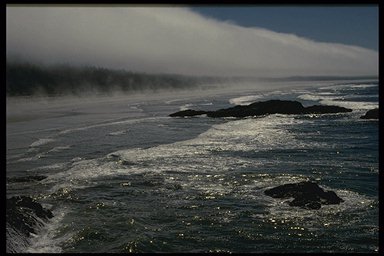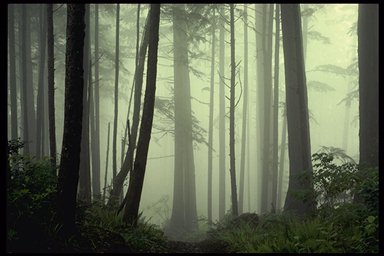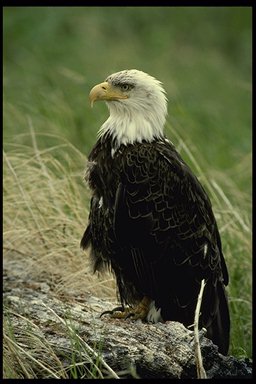

The biggest trees, the most rainfall, the longest and deepest fiords ... this region is known for Canadian superlatives. A distinctive climate and lofty mountains make this natural region stand alone, like an island, with unique plant and animal communities and living conditions.
In few other natural regions of Canada can one swim or walk through such a diversity of habitats, or experience such a variety of life, in so short a distance - from undersea kelp forests through lush rain forests to arctic conditions on mountain-top glaciers. The Coast Mountains cover most of the region, rising steeply from the fiords and channels. Mount Waddington, the highest mountain in British Columbia, is over 4000 metres. Glaciers and snowfields cap the tallest ranges. The mountains of Vancouver Island and the Queen Charlottes, although not high, make up in ruggedness what they lack in elevation. The Estevan Coastal Plain, a long narrow strip of rocky coastline, indented, wave-battered and wind-scoured, separates the mountains from the sea along the west coast of Vancouver Island.

The region lies within the Pacific Ring of Fire, an area of high volcanic and earthquake activity caused by the movement of crustal plates. Hot springs that beckon backcountry explorers bear testimony to crustal "hot spots" found throughout this region.
VEGETATION:
The combination of heavy rainfall and year-round mild temperatures have resulted in some of the most spectacular old-growth temperate rain forests in the world. Here are the most productive forests, the biggest trees and some of the oldest trees in Canada - the Red Creek fir, a massive Douglas fir with a circumference of over 14 metres and a height of 80 metres, possibly Canada's biggest tree; the largest western red cedar, 20 metres in circumference, found on Meares Island; Carmanah Creek, site of the world's tallest sitka spruce (95metres); Cathedral Grove, dominated by Douglas fir as tall in feet as they are old in years - up to 250 feet (85 metres) and 250 years. Yet these are mere babes compared to many western red cedars, which can be over two millennia old.
Three main types of vegetation occur in Natural Region 1. The Coastal Western Hemlock zone occurs only to about 600 metres above sea level. Douglas fir,sitka spruce, western red cedar and western hemlock are the dominant species in this zone. Between 600 metres and 900 metres above sea level is the sub-alpine mountain hemlock zone dominated by mountain hemlock and yellow cedar. As the elevation increases, the green cloak of evergreen forest begins to break up into krummholz - stunted clumps of trees. Above 900 metres is the third vegetation zone - treeless alpine tundra.
WILDLIFE:
The mainland coast of Natural Region 1 is a stronghold for grizzly bears, which feed heavily on salmon migrating to their spawning streams. Cougar, wolf, black bear, martin, black-tailed deer (a sub-species of mule deer), wapiti (elk), mountain goat, wolverine and fisher are some of the larger denizens of this region. Several endemic sub-species and species of wildlife have evolved on the islands of this region: the Vancouver Island marmot, found only in alpine meadows on Vancouver Island; the "blond" or "kermodei" bear, a pale sub-species of black bear found on a few north coastal islands; the Roosevelt elk, among others.Some of these endemics are rare or endangered; others, such as the Dawson caribou, once confined to Graham Island in the Queen Charlotte Islands, are now extinct.

The marine environment of this region supports an abundance of life unrivalled in Canada. Many large seabird colonies, some with populations of global significance, are found on islands along the coast of this region. Bald eagles are a common sight along the coast. The region's estuaries, rocky shorelines and beaches provide critical habitat for countless migrating shorebirds and waterfowl, including the trumpeter swan and sandhill crane.
STATUS OF NATIONAL PARKS:
This region is represented by Pacific Rim National Park Reserve (500 km2) and Gwaii Haanas National Park Reserve (1495 km2). Pacific Rim, representing the Estevan Coastal Plain portion of this region, is divided into three distinct units: Long Beach, a strip of uninterrupted surf-pounded beach backed by rain forest and including a marine component extending to the 10-fathom line; the Broken Group Islands, consisting of over 100 islands in a marine component; and a narrow strip along 77 kilometres of coastline that includes the challenging West Coast Trail and an inland wilderness watershed known as the Nitinat Triangle.
The first federal-provincial agreement for Pacific Rim was signed in 1970. This agreement was re-negotiated in 1987. Because the area is subject to the comprehensive claim of the Nuu-chah-nulth Tribal Council and the Ditidaht First Nation, it will be proclaimed as a national park reserve under the National Parks Act, pending the resolution of this claim.
Gwaii Haanas National Park Reserve, encompassing the rain forests and alpine meadows of the southern Queen Charlotte Islands,harbours 39 species of plants and animals not found anywhere else on the globe. Gwaii Haanas, which means "islands of wonder and beauty", is the Haida name for this wilderness archipelago of 138 islands. Accessible only by boat or aircraft, this diverse area harbours over one-quarter of B.C.'s nesting seabirds, high concentrations of bald eagles and peregrine falcons, and Canada's largest sea lion rookery. Vegetation varies from endemic plants of the alpine meadows of the rugged San Christoval Mountains to the towering sitka spruce of coastal rain forests. The interplay of land and marine environments, coupled with the abundance of Haida heritage features, distinguishes this park reserve. The Haida legacy includes the historical village of Ninstints on Anthony Island, a UNESCO cultural World Heritage Site, as well as over 100 inventoried archaeological sites of an estimated total in excess of 450.
A federal-provincial agreement was signed in 1988 committing Canada and British Columbia to create a national park and an adjacent national marine conservation area. Recognizing that the area falls within the traditional territory of the Haida Nation that will be subject to treaty negotiation, an agreement was negotiated between Canada and the Council of the Haida Nation related to sharing in planning, operation and management. The National Parks Act is in the process of being amended to establish the national park reserve consistent with the above-mentioned agreements.